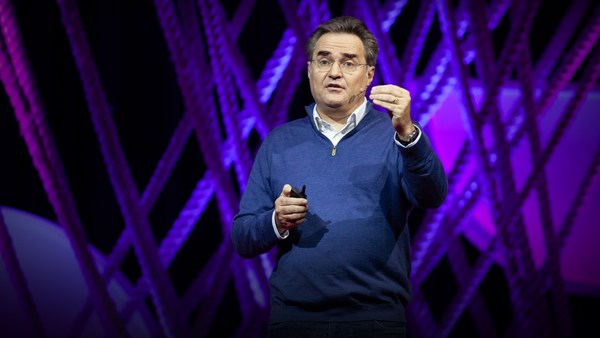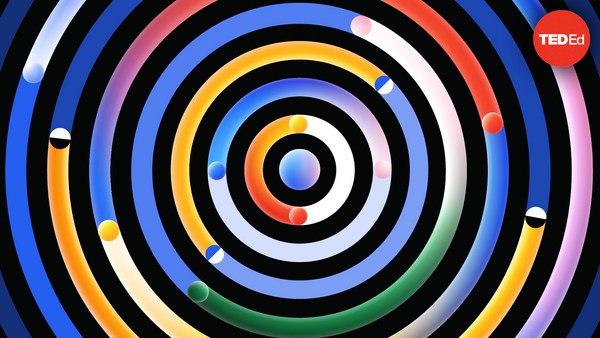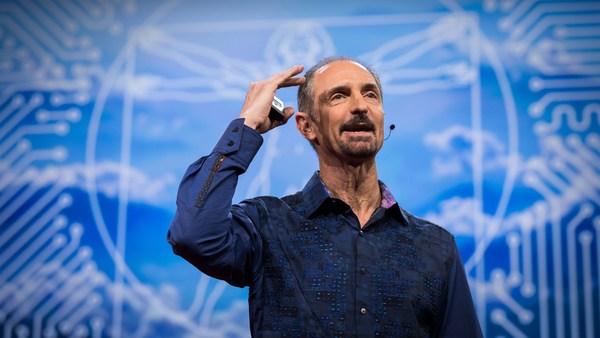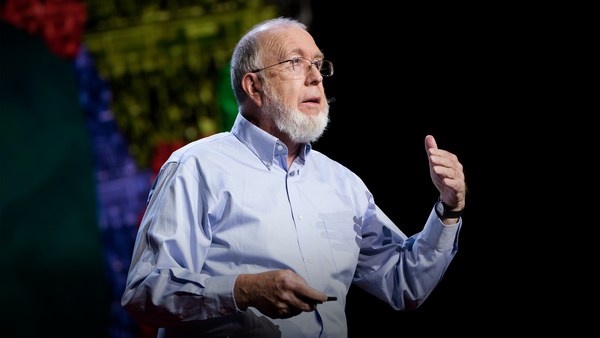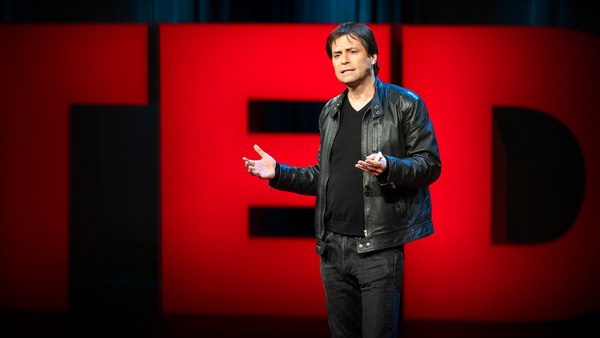I've been working in AI for most of my career, helping companies build artificial intelligence capabilities to improve their business, which is why I think what I'm about to tell you is quite shocking. Every year, thousands of companies across the world spend collectively tens of billions of dollars to build AI capabilities. But according to research my colleagues and I have done, only about 10 percent of these companies get any meaningful financial impact from their investments. These 10 percent winners with AI have a secret. And their secret is not about fancy algorithms or sophisticated technology. It's something far more basic. It's how they get their people and AI to work together. Together, not against each other, not instead of each other. Together in a mutually beneficial relationship.
Unfortunately, when most people think about AI, they think about the most extreme cases. That AI is here only to replace us or overtake our intelligence and make us unnecessary. But what I'm saying is that we don't seem to quite appreciate the huge opportunity that exists in the middle ground, where humans and AI come together to achieve outcomes that neither one could do alone on their own.
Consider the game of chess. You probably knew that AI today can beat any human grandmaster. But did you know that the combination of a human chess player and AI can beat not only any human but also any machine. The combination is much more powerful than the sum of its parts. In a perfect combination, AI will do what it does best, which is dealing with massive amounts of data and solving complex problems. And humans do what we do best using our creativity, our judgment, our empathy, our ethics and our ability to compromise.
For several years, my colleagues and I have studied and worked with hundreds of winning companies who are successfully building these human-AI relationships. And what we've seen is quite interesting. First of all, these companies get five times more financial value than companies who use AI only to replace people. Most importantly, they have a happier workforce. Their employees are more proud, more fulfilled, they collaborate better with each other, and they're more effective. Five times more value and a happier workforce.
So the question is, how do these companies do it? How do they achieve these symbiotic human-AI relationships? I have some answers. First of all, they don't think of AI in the most extreme case only to replace humans. Instead, they look deep inside their organizations and at the various roles their people play. And they ask: How can AI make our people more fulfilled, more effective, more amplified? Let me give you an example. Humana is a health care company here in the US. It has pharmacy call centers where pharmacists work with patients over the phone. It's a job that requires a fair amount of empathy and humanity. Humana has developed an AI system that listens to the pharmacists' conversation and picks up emotional and tone signals and then gives real-time suggestions to the pharmacists on how to improve the quality of that conversation. For example, it might say “Slow down” or “Pause” or "Hey, consider how the other person is feeling right now." All to improve the quality of that conversation. I'm pretty sure my wife would buy me one of these if she could, just to help me in some of my conversations with her.
(Laughter)
Turns out the pharmacists like it quite a lot, too. They're more effective in their jobs, but they also learn something about themselves, their own behaviors and biases. The result has been more effective pharmacists and much higher customer satisfaction scores.
Now, this is just one example of many possibilities where human AI collaborate. In this example, AI was a recommender. It didn't replace the human or make any decisions of its own. It simply made suggestions, and it was up to the person to decide and act. And at the heart of it is a feedback loop, which, by the way, is very critical for any human-AI relationship. By that I mean that in this example, first AI had to learn from humans the qualities that would make up a good or not so good conversation. And then over time, as AI built more intelligence, it would be able to make suggestions, but it would be up to the person to decide and act. And if they didn't agree with the recommendation because it might have not made sense to them, they didn't have to. In which case AI might learn something and adapt for the future. It's basically open, frequent, two-way communication, like any couples therapist will tell you, is very important for any good relationship.
Now the key word here is relationship. Think about your own personal relationships with other people. You don't have the same kind of relationship with your accountant or your boss or your spouse, do you? Well, I certainly hope not. And just like that, the right relationship between human and AI in a company is not a one-size-fits-all. So in the case of Humana, AI was a recommender and a human was decision-maker and actor. In some other examples, AI might be an evaluator where a human comes up with ideas or scenarios, and AI evaluates the complex implications and tradeoffs of those ideas and makes it easy for humans to decide the best course of action. In some other examples, AI might take a more creative role. It could be an illuminator where it can take a complex problem and come up with potential solutions to that problem and illuminate some options that might have been impossible for humans to see.
Let me give you another example. During the COVID pandemic, if you walked into a retail or grocery store, you saw that many retailers were struggling. Their shelves were empty, their suppliers were not able to fulfill the orders, and with all the uncertainties of the pandemic, they simply had no idea how many people would be walking into what stores, demanding what products. Now, to put this in perspective, this is a problem that's already quite hard when things are normal. Retailers have to predict demand for tens of thousands of products across thousands of locations and thousands of suppliers every day to manage and optimize their inventory. Add to that the uncertainties of COVID and the global supply chain disruptions, and this became 100 times more difficult. And many retailers were simply paralyzed. But there were a few who had built strong foundations with AI and the human-AI feedback loop that we talked about. And these guys were able to navigate all this uncertainty much better than others. They used AI to analyze tens of billions of data points on consumer behavior and global supply chain disruptions and local government closures and mandates and traffic on highways and ocean freight lanes and many, many other factors and get a pretty good handle on what consumers in each unique area wanted the most, what would have been feasible, and for items that were not available, what substitutions could be made. But AI alone without the human touch wouldn't work either. There were ethical and economic tradeoffs that had to be considered. For example, deciding to bring in a product that didn't have a good margin for the retailer but would really help support the local community at their time of need. After all, AI couldn't quite understand the uniquely human behavior of panic-buying toilet paper or tens of gallons of liquor, only to be used as hand sanitizer. It was the combination that was the key.
And the winning companies know this. They also know that inside their companies, there's literally hundreds of these opportunities for human-AI combination, and they actively identify and pursue them. They think of AI as much more broadly a means to replace people. They look inside their organizations and re-imagine how the biggest challenges and opportunities of their company can be addressed by the combination of human and AI. And they put in place the right combination for each unique situation. Whether it's the recommender or the evaluator or the illuminator or optimizer or many, many other ones. They build and evolve the feedback loops that we talked about. And finally and most importantly, they don't just throw technology at it. In fact, this has been the biggest pitfall of companies who don't get their return from their AI investments. If they overinvest in technology expecting a piece of tech to solve all their problems. But there is no silver bullet. Technology and automation can only go so far, and for every one automation opportunity inside a company, there's literally ten for collaboration. But collaboration's hard. It requires a new mindset and doing things differently than how we've always done it.
And the winning companies know this, too, which is why they don't just invest in technology, but so much more on human factors, on their people, on training and reskilling and reimagining how their people and AI work together in new ways. Inside these companies, it's not just machines replacing humans. It's machines and humans working together, learning from each other. And when that happens, the organization's overall rate of learning increases, which in turn makes the company much more agile, much more resilient, ready to adapt and take on any challenge. It is the human touch that will bring the best out of AI.
Thank you.
(Applause)
